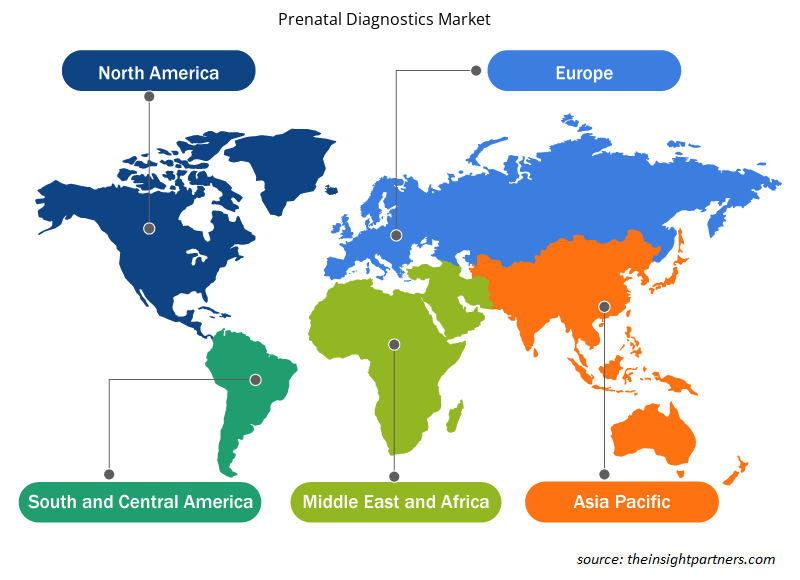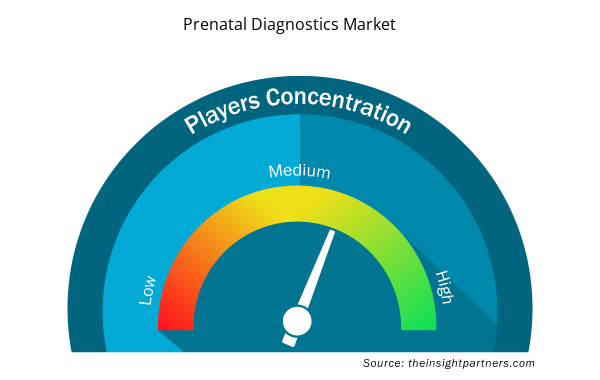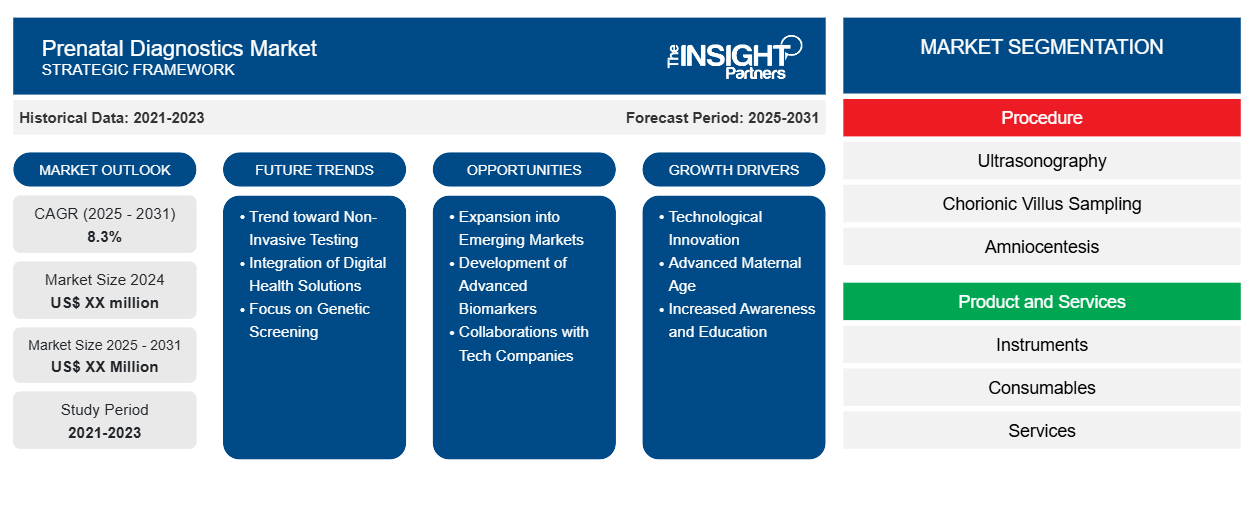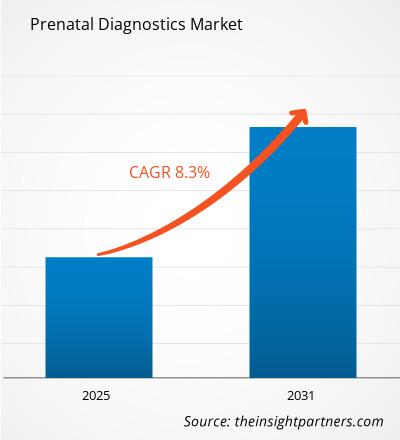Se espera que el mercado de diagnóstico prenatal registre una CAGR del 8,3 % entre 2024 y 2031, con un tamaño de mercado que se expandirá de US$ XX millones en 2024 a US$ XX millones en 2031.
El informe está segmentado por procedimiento (ecografía, muestreo de vellosidades coriónicas, amniocentesis, muestreo percutáneo de sangre umbilical, diagnóstico genético preimplantacional); producto y servicios (instrumentos, consumibles, servicios); aplicación (anomalías cromosómicas, trastornos genéticos); usuario final (hospitales, laboratorios de diagnóstico). El análisis global se desglosa aún más a nivel regional y por países principales. El informe ofrece el valor en USD para el análisis y los segmentos anteriores.
Propósito del Informe
El informe Prenatal Diagnostics Market de The Insight Partners tiene como objetivo describir el panorama actual y el crecimiento futuro, los principales factores impulsores, los desafíos y las oportunidades. Esto proporcionará información a diversas partes interesadas del negocio, como:
- Proveedores/fabricantes de tecnología: Para comprender la dinámica cambiante del mercado y conocer las oportunidades potenciales de crecimiento, lo que les permitirá tomar decisiones estratégicas informadas.
- Inversionistas: Realizar un análisis exhaustivo de tendencias sobre la tasa de crecimiento del mercado, las proyecciones financieras del mercado y las oportunidades que existen en toda la cadena de valor.
- Órganos reguladores: Regular las políticas y vigilar las actividades del mercado con el objetivo de minimizar los abusos, preservar la confianza de los inversores y defender la integridad y la estabilidad del mercado.
Segmentación del mercado de diagnóstico prenatal
Procedimiento
- Ultrasonografía
- Muestreo de vellosidades coriónicas
- Amniocentesis
- Toma de muestra de sangre umbilical percutánea
- Diagnóstico genético preimplantacional
Productos y servicios
- Instrumentos
- Consumibles
- Servicios
Solicitud
- Anormalidad cromosómica
- Trastornos genéticos
Usuario final
- Hospitales
- Laboratorios de diagnóstico
Personalice este informe según sus necesidades
Obtendrá personalización en cualquier informe, sin cargo, incluidas partes de este informe o análisis a nivel de país, paquete de datos de Excel, así como también grandes ofertas y descuentos para empresas emergentes y universidades.
- Obtenga las principales tendencias clave del mercado de este informe.Esta muestra GRATUITA incluirá análisis de datos, desde tendencias del mercado hasta estimaciones y pronósticos.
Factores impulsores del crecimiento del mercado de diagnóstico prenatal
- Innovación tecnológica: Las nuevas tecnologías, como las pruebas prenatales no invasivas (NIPT, por sus siglas en inglés) y otras tecnologías avanzadas de diagnóstico por imagen, están cambiando drásticamente el campo de juego. Las tecnologías que se utilizan aquí buscan proporcionar diagnósticos más seguros y precisos sobre la salud del feto, lo que permite evitar por completo los riesgos de los procedimientos invasivos. Las capacidades de diagnóstico avanzadas, incluida la capacidad de proporcionar intervenciones oportunas, promueven una demanda cada vez mayor de soluciones de pruebas prenatales más avanzadas por parte de los futuros padres.
- Edad materna avanzada: La sociedad ha evolucionado y la mayoría de las mujeres prefieren dar a luz a sus bebés a una edad más avanzada, lo que las coloca en un mayor riesgo de trastornos genéticos y otras complicaciones durante el embarazo. Por lo tanto, este factor requiere exámenes y diagnósticos prenatales más completos, ya que las mujeres mayores buscan tomar el control y garantizar embarazos saludables. En realidad, son los principales riesgos los que obligan a la pareja a invertir en estos nuevos servicios de atención prenatal.
- Mayor concienciación y educación: una mayor concienciación sobre la importancia de los diagnósticos prenatales está cambiando el comportamiento de los consumidores. Como resultado, el aumento de la actividad educativa y la accesibilidad al conocimiento permiten a los futuros padres buscar opciones informadas en materia de salud tanto para la madre como para el bebé. Este cambio hacia servicios de salud proactivos está impulsando el fenómeno de los servicios de pruebas prenatales, en los que los padres buscan la detección temprana y la prevención de posibles problemas.
Tendencias futuras del mercado de diagnóstico prenatal
- Tendencia hacia las pruebas no invasivas: existe una tendencia hacia las pruebas prenatales no invasivas, que se sabe que brindan evaluaciones seguras y precisas del estado del feto sin los riesgos de los procedimientos invasivos en sí. Esta tendencia ha cobrado fuerza con los años gracias a los avances tecnológicos y a la concienciación entre los futuros padres, lo que ha aumentado la demanda de pruebas prenatales no invasivas y las ha convertido en un método inicial adecuado para la mayoría de las pruebas prenatales.
- Integración de soluciones de salud digital: con la integración de la telemedicina y las aplicaciones de salud móvil, se abre una puerta a la introducción de nuevas tecnologías de salud digital en el diagnóstico prenatal. Los resultados de las pruebas prenatales y las consultas remotas permitirán mejoras para aumentar la comodidad y la participación de los pacientes. Es parte de una tendencia emergente de demanda de soluciones de salud personalizadas y accesibles en el diagnóstico prenatal entre los futuros padres.
- Enfoque en el cribado genético: existe una tendencia creciente de cribado genético en el mercado de diagnóstico prenatal. En este contexto, con el avance del conocimiento y el reconocimiento cada vez mayor de las enfermedades hereditarias, los futuros padres buscan las evaluaciones genéticas más exhaustivas para determinar los riesgos en cualquier etapa temprana. Esta tendencia eventualmente impulsará la creación de soluciones de pruebas más específicas, la colaboración entre proveedores de atención médica y asesores genéticos y, como consecuencia, una mejor prestación de atención.
Oportunidades de mercado en el diagnóstico prenatal
- Expansión a mercados emergentes: Los mercados en crecimiento representan una gran oportunidad para el sector de diagnóstico prenatal. Con el desarrollo de la infraestructura sanitaria y la creciente concienciación sobre la atención prenatal, aumenta la demanda de tecnologías de diagnóstico de mayor calidad. Por lo tanto, se pueden aprovechar las plataformas de pruebas de bajo costo y la educación en áreas hasta ahora con escasez de recursos para lograr un mayor acceso a los servicios prenatales.
- Desarrollo de biomarcadores avanzados: descubrimiento e identificación de nuevos biomarcadores Los biomarcadores para el diagnóstico prenatal son un área que va a presenciar "avances" innovadores. Los avances en la vanguardia tanto en genómica como en proteómica podrán abrir caminos que conduzcan al desarrollo de pruebas muy sensibles y predictivas en una amplia gama de enfermedades. A continuación, se muestra cómo esta posible ruta hacia la medicina de precisión mejora la evaluación de la salud fetal al tiempo que ofrece una forma de personalizar la atención prenatal para padres preocupados por el bienestar.
- Colaboraciones con empresas tecnológicas: las empresas que trabajan con tecnologías colaborarán con otras para acelerar la innovación en el diagnóstico prenatal. Existe una integración de la inteligencia artificial y el aprendizaje automático en el software de diagnóstico, lo que acelera el análisis de datos y la evaluación de riesgos. Esto podría aumentar la oferta de productos, facilitar plataformas más intuitivas y fáciles de usar y cambiar la cara de la atención prenatal para los futuros padres.
Perspectivas regionales del mercado de diagnóstico prenatal
Los analistas de Insight Partners explicaron en detalle las tendencias y los factores regionales que influyen en el mercado de diagnóstico prenatal durante el período de pronóstico. Esta sección también analiza los segmentos y la geografía del mercado de diagnóstico prenatal en América del Norte, Europa, Asia Pacífico, Oriente Medio y África, y América del Sur y Central.

- Obtenga datos regionales específicos para el mercado de diagnóstico prenatal
Alcance del informe de mercado de diagnóstico prenatal
| Atributo del informe | Detalles |
|---|---|
| Tamaño del mercado en 2024 | XX millones de dólares estadounidenses |
| Tamaño del mercado en 2031 | US$ XX millones |
| Tasa de crecimiento anual compuesta (CAGR) global (2025-2031) | 8,3% |
| Datos históricos | 2021-2023 |
| Período de pronóstico | 2025-2031 |
| Segmentos cubiertos | Por procedimiento
|
| Regiones y países cubiertos | América del norte
|
| Líderes del mercado y perfiles de empresas clave |
|
Densidad de actores del mercado de diagnóstico prenatal: comprensión de su impacto en la dinámica empresarial
El mercado de diagnóstico prenatal está creciendo rápidamente, impulsado por la creciente demanda de los usuarios finales debido a factores como la evolución de las preferencias de los consumidores, los avances tecnológicos y una mayor conciencia de los beneficios del producto. A medida que aumenta la demanda, las empresas amplían sus ofertas, innovan para satisfacer las necesidades de los consumidores y aprovechan las tendencias emergentes, lo que impulsa aún más el crecimiento del mercado.
La densidad de actores del mercado se refiere a la distribución de las empresas o firmas que operan dentro de un mercado o industria en particular. Indica cuántos competidores (actores del mercado) están presentes en un espacio de mercado determinado en relación con su tamaño o valor total de mercado.
Las principales empresas que operan en el mercado de diagnóstico prenatal son:
- GE Healthcare (Compañía General Electric)
- Termo Fisher Scientific, Inc.
- Ilumina, Inc.
- F. Hoffman-La Roche Ltd.
- Instituto de Genómica de Beijing
Descargo de responsabilidad : Las empresas enumeradas anteriormente no están clasificadas en ningún orden particular.

- Obtenga una descripción general de los principales actores clave del mercado de diagnóstico prenatal
Puntos de venta clave
- Cobertura integral: el informe cubre de manera integral el análisis de productos, servicios, tipos y usuarios finales del mercado de diagnóstico prenatal, proporcionando un panorama holístico.
- Análisis de expertos: el informe se compila sobre la base de un profundo conocimiento de expertos y analistas de la industria.
- Información actualizada: El informe asegura relevancia comercial debido a su cobertura de información reciente y tendencias de datos.
- Opciones de personalización: este informe se puede personalizar para satisfacer los requisitos específicos del cliente y adaptarse adecuadamente a las estrategias comerciales.
Por lo tanto, el informe de investigación sobre el mercado de diagnóstico prenatal puede ayudar a abrir camino para descifrar y comprender el escenario de la industria y las perspectivas de crecimiento. Si bien puede haber algunas preocupaciones válidas, los beneficios generales de este informe tienden a superar las desventajas.
- Análisis histórico (2 años), año base, pronóstico (7 años) con CAGR
- Análisis PEST y FODA
- Tamaño del mercado Valor/volumen: global, regional, nacional
- Industria y panorama competitivo
- Conjunto de datos de Excel



Report Coverage
Revenue forecast, Company Analysis, Industry landscape, Growth factors, and Trends

Segment Covered
This text is related
to segments covered.

Regional Scope
North America, Europe, Asia Pacific, Middle East & Africa, South & Central America

Country Scope
This text is related
to country scope.
Preguntas frecuentes
Asia Pacific is estimated to grow at the highest CAGR over the forecast year (2023 - 2031)
The North America region accounts for highest revenue share prenatal diagnostics market
The final report will duly include market size and projection estimates for all the segments from 2021 to 2031, along with a revenue share and compound annual growth rate (%) for the regional
/
country-wise market wherein 2021-2022 are the historic years, 2023 is considered to be the base year, and the forecast will be provided till 2031, along with CAGR (%)
The market is expected to grow at a CAGR of 8.3%
advanced maternal age and increased awareness and education about prenatal diagnostics are the major factors boosting the prenatal diagnostics market growth
GE Healthcare (General Electric Company), Thermo Fisher Scientific, Inc., Illumina, Inc., F. Hoffman-La Roche Ltd., Beijing Genomics Institute, Agilent Technologies, Inc., Perkinelmer, Inc., Hologic, Inc., Natera, Inc., Quest Diagnostics, Inc. are the some of the key market players operating in the prenatal diagnostics market
Trends and growth analysis reports related to Life Sciences : READ MORE..
1. GE Healthcare (General Electric Company)2. Thermo Fisher Scientific, Inc.3. Illumina, Inc.4. F. Hoffman-La Roche Ltd.5. Beijing Genomics Institute6. Agilent Technologies, Inc.7. Perkinelmer, Inc.8. Hologic, Inc.9. Natera, Inc.10. Quest Diagnostics, Inc.
The Insight Partners performs research in 4 major stages: Data Collection & Secondary Research, Primary Research, Data Analysis and Data Triangulation & Final Review.
- Data Collection and Secondary Research:
As a market research and consulting firm operating from a decade, we have published and advised several client across the globe. First step for any study will start with an assessment of currently available data and insights from existing reports. Further, historical and current market information is collected from Investor Presentations, Annual Reports, SEC Filings, etc., and other information related to company’s performance and market positioning are gathered from Paid Databases (Factiva, Hoovers, and Reuters) and various other publications available in public domain.
Several associations trade associates, technical forums, institutes, societies and organization are accessed to gain technical as well as market related insights through their publications such as research papers, blogs and press releases related to the studies are referred to get cues about the market. Further, white papers, journals, magazines, and other news articles published in last 3 years are scrutinized and analyzed to understand the current market trends.
- Primary Research:
The primarily interview analysis comprise of data obtained from industry participants interview and answers to survey questions gathered by in-house primary team.
For primary research, interviews are conducted with industry experts/CEOs/Marketing Managers/VPs/Subject Matter Experts from both demand and supply side to get a 360-degree view of the market. The primary team conducts several interviews based on the complexity of the markets to understand the various market trends and dynamics which makes research more credible and precise.
A typical research interview fulfils the following functions:
- Provides first-hand information on the market size, market trends, growth trends, competitive landscape, and outlook
- Validates and strengthens in-house secondary research findings
- Develops the analysis team’s expertise and market understanding
Primary research involves email interactions and telephone interviews for each market, category, segment, and sub-segment across geographies. The participants who typically take part in such a process include, but are not limited to:
- Industry participants: VPs, business development managers, market intelligence managers and national sales managers
- Outside experts: Valuation experts, research analysts and key opinion leaders specializing in the electronics and semiconductor industry.
Below is the breakup of our primary respondents by company, designation, and region:

Once we receive the confirmation from primary research sources or primary respondents, we finalize the base year market estimation and forecast the data as per the macroeconomic and microeconomic factors assessed during data collection.
- Data Analysis:
Once data is validated through both secondary as well as primary respondents, we finalize the market estimations by hypothesis formulation and factor analysis at regional and country level.
- Macro-Economic Factor Analysis:
We analyse macroeconomic indicators such the gross domestic product (GDP), increase in the demand for goods and services across industries, technological advancement, regional economic growth, governmental policies, the influence of COVID-19, PEST analysis, and other aspects. This analysis aids in setting benchmarks for various nations/regions and approximating market splits. Additionally, the general trend of the aforementioned components aid in determining the market's development possibilities.
- Country Level Data:
Various factors that are especially aligned to the country are taken into account to determine the market size for a certain area and country, including the presence of vendors, such as headquarters and offices, the country's GDP, demand patterns, and industry growth. To comprehend the market dynamics for the nation, a number of growth variables, inhibitors, application areas, and current market trends are researched. The aforementioned elements aid in determining the country's overall market's growth potential.
- Company Profile:
The “Table of Contents” is formulated by listing and analyzing more than 25 - 30 companies operating in the market ecosystem across geographies. However, we profile only 10 companies as a standard practice in our syndicate reports. These 10 companies comprise leading, emerging, and regional players. Nonetheless, our analysis is not restricted to the 10 listed companies, we also analyze other companies present in the market to develop a holistic view and understand the prevailing trends. The “Company Profiles” section in the report covers key facts, business description, products & services, financial information, SWOT analysis, and key developments. The financial information presented is extracted from the annual reports and official documents of the publicly listed companies. Upon collecting the information for the sections of respective companies, we verify them via various primary sources and then compile the data in respective company profiles. The company level information helps us in deriving the base number as well as in forecasting the market size.
- Developing Base Number:
Aggregation of sales statistics (2020-2022) and macro-economic factor, and other secondary and primary research insights are utilized to arrive at base number and related market shares for 2022. The data gaps are identified in this step and relevant market data is analyzed, collected from paid primary interviews or databases. On finalizing the base year market size, forecasts are developed on the basis of macro-economic, industry and market growth factors and company level analysis.
- Data Triangulation and Final Review:
The market findings and base year market size calculations are validated from supply as well as demand side. Demand side validations are based on macro-economic factor analysis and benchmarks for respective regions and countries. In case of supply side validations, revenues of major companies are estimated (in case not available) based on industry benchmark, approximate number of employees, product portfolio, and primary interviews revenues are gathered. Further revenue from target product/service segment is assessed to avoid overshooting of market statistics. In case of heavy deviations between supply and demand side values, all thes steps are repeated to achieve synchronization.
We follow an iterative model, wherein we share our research findings with Subject Matter Experts (SME’s) and Key Opinion Leaders (KOLs) until consensus view of the market is not formulated – this model negates any drastic deviation in the opinions of experts. Only validated and universally acceptable research findings are quoted in our reports.
We have important check points that we use to validate our research findings – which we call – data triangulation, where we validate the information, we generate from secondary sources with primary interviews and then we re-validate with our internal data bases and Subject matter experts. This comprehensive model enables us to deliver high quality, reliable data in shortest possible time.


 Obtenga una muestra gratuita de este informe
Obtenga una muestra gratuita de este informe